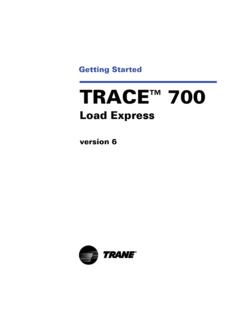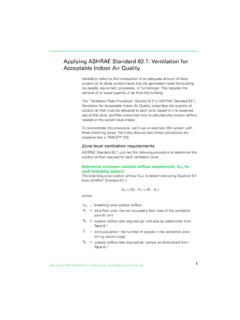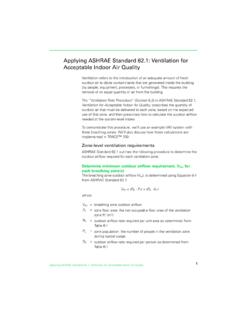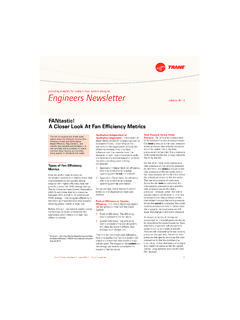Transcription of Coil loop for exhaust-air energy recovery - Trane
1 Coil loop for exhaust -air energy recovery An exhaust -air energy - recovery system can reduce utility costs by capturing and using energy that would normally be lost to the Devices (including total- exhaust air stream. energy wheels and heat pipes) other than the coil A coil loop can be applied either to the primary supply-air system loop described here can or to independent systems such as the dedicated ventilation exchange sensible and/or system that serves a laboratory. The effectiveness of the coil latent heat for energy loop typically ranges from 45 percent to 60 percent for recovery . recovering sensible heat.
2 Figure 4 2 illustrates how the coil loop works. During the heating season (Inset A), heat extracted from the exhaust air stream (EA). warms the air brought into the building. Operation of the coil loop is limited to prevent the supply-air temperature from exceeding the cooling set point. (This condition is most likely to occur on mild days during the spring and fall.) Preconditioning the outdoor air (OA) in this manner reduces the heating load, which in turn reduces the energy consumption of the HVAC system. Figure 4 2 Operating modes for coil-loop energy recovery Inset A winter operation Inset B summer operation Coil-loop operation reverses during the cooling season (Inset B).
3 Sensible heat is extracted from the air brought into the building and is rejected to the cooler and drier exhaust air stream. This time, preconditioning by the coil loop reduces the cooling load and, in turn, the energy consumption of the HVAC system. 4 8 System Design Options TRACE 700 User's Manual CDS-PRM001-EN. Coil loop for exhaust -air energy recovery A coil loop also called a coil runaround loop consists of two or more finned-tube coils that are piped together in a closed loop. A. small pump circulates the working fluid (usually a solution of inhibited glycol and water) through the two coils. An expansion tank and a means for modulating capacity, either a three-way mixing valve or a variable-frequency drive on the pump, complete this energy - recovery device.
4 Figure 4 3, and Figure 4 4 on page 4 10, show the typical arrangements for sensible-heat recovery in mixed-air and dedicated ventilation systems. In Figure 4 3, which shows mixed-air systems, sensible-heat recovery can be used to reheat the dehumidified supply air for independent control of both temperature and humidity (Insets A and C), or to precondition the outdoor air (Insets B and C). Figure 4 3 Mixed-air arrangements Inset A parallel recovery Inset B parallel recovery Inset C series transfer (stream to stream) (stream to stream) (upstream to downstream). In Figure 4 4 on page 4 10, which shows dedicated ventilation systems, sensible-heat recovery is often used to reheat the dehumidified outdoor air (Insets A and C), or to precondition the outdoor air (Insets B and C).
5 Insets A and C are typically used with systems that deliver dehumidified outdoor air at a neutral dry-bulb temperature. Each of the arrangements in Figure 4 3 and Figure 4 4 can be modeled using TRACE 700. However, only the arrangement shown in Figure 4 4, Inset C, will be covered in this discussion of coil-loop energy recovery . For arrangements other than this one, select the appropriate energy - recovery configuration (similar to step 2 in this example) and refer to the following: CDS-PRM001-EN TRACE 700 User's Manual System Design Options 4 9. Coil loop for exhaust -air energy recovery Figure 4 4 Dedicated ventilation arrangements Inset A parallel recovery Inset B parallel recovery Inset C series transfer (stream to stream) (stream to stream) (upstream to downstream).
6 Figure 4 3: for Inset A, refer to steps 1 through 6 in Fixed-plate heat exchanger on page 4 21. for Inset B, refer to steps 1 through 6 in Total- energy (enthalpy). wheel on page 4 15. for Inset C, refer to steps 1 through 6 in Heat pipe on page 4 . 27. Figure 4 4: for Inset A, refer to steps 1 through 6 in Sensible wheel on page 4 34. for Inset B, refer to steps 1 through 6 in Total- energy (enthalpy). wheel on page 4 15. Application considerations Coil-loop energy recovery increases the static pressure on both sides of the air-distribution system supply and exhaust . Contact the manufacturers of the heat-exchange devices for estimated pressure drops.
7 Unlike other types of exhaust -air energy recovery , a coil-loop recovery system does not require close proximity of the exhaust , supply, or makeup air streams. It can recover heat from diverse exhaust locations scattered throughout the building. 4 10 System Design Options TRACE 700 User's Manual CDS-PRM001-EN. Coil loop for exhaust -air energy recovery Related reading Air-to-Air energy recovery , engineers newsletter (volume 29, number 5). Air-to-Air energy recovery in HVAC Systems Applications Engineering Manual ( Trane literature number SYS-APM003-EN). Sample scenario To input the type of heat recovery in Figure 4 4, Inset C, we will model an office building with a dedicated ventilation unit (makeup-air unit) that dehumidifies the outdoor air, and then reheats the air to a room neutral dry-bulb temperature before the air is delivered directly to the space.
8 Water-source heat-pump (WSHP) units are installed in the ceiling plenum above each room and handle the cooling and heating needs for the rooms. To reduce the amount of reheat energy needed, and to increase the dehumidification capacity of the cooling coil in the dedicated ventilation unit, a coil loop is used to precool the outdoor air stream before it enters the optional ventilation-unit cooling coil, and then reheat the dehumidified outdoor air after it leaves the optional ventilation-unit cooling coil. Note: For details on modeling the WSHP portion of the system, refer to Water-source heat-pump system on page 3 68.
9 For details on modeling the Dedicated Ventilation Unit portion of the system, refer to Dedicated outdoor-air systems on page 4 45. To model the coil-loop scenario: 1 On the Actions list, select Change Load Parameters and define the first month and last month of the summer (cooling) season. These entries help determine when the energy recovery / transfer device provides cooling rather than heating. CDS-PRM001-EN TRACE 700 User's Manual System Design Options 4 11. Coil loop for exhaust -air energy recovery 2 After defining the system, click the Options tab and select the desired Click Yes to activate energy air-to-air energy recovery / recovery for design and energy transfer type, which analysis.
10 Click No to ignore energy recovery during the determines the type of design calculation and include it energy recovery / transfer only during the energy -analysis and the basic simulation. configuration. In this case, Coil loop (series Note: This message will only supply-air tempering). appear whenever an energy recovery / transfer device is 3 A message will appear added and Allow energy that asks whether the recovery / transfer during user wants to account for design calculations is turned energy recovery / transfer off. during the design and energy analysis simulations or only during the energy analysis simulation.





